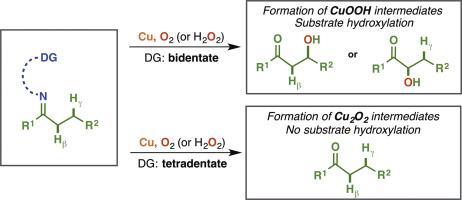Journal of Inorganic Biochemistry ( IF 3.8 ) Pub Date : 2021-07-20 , DOI: 10.1016/j.jinorgbio.2021.111557 Shuming Zhang 1 , Rachel Trammell 1 , Alexandra Cordova 1 , Maxime A Siegler 2 , Isaac Garcia-Bosch 1

|
In this research article, we describe the Cu-promoted intramolecular hydroxylation of sp2 and sp3 C H bonds using directing groups with varying denticity (bi-, tri- and tetradentate) and natural oxidants (O2 and H2O2). We found that bidentate directing groups, in combination with Cu and H2O2, led to high hydroxylation yields. On the other hand, tetradentate directing groups did not form the hydroxylation products. Our mechanistic investigations suggest that bidentate directing groups allow for generating reactive mononuclear copper(II) hydroperoxide intermediates while tetradentate systems form dinuclear Cu2O2 species that do not oxidize C
H bonds using directing groups with varying denticity (bi-, tri- and tetradentate) and natural oxidants (O2 and H2O2). We found that bidentate directing groups, in combination with Cu and H2O2, led to high hydroxylation yields. On the other hand, tetradentate directing groups did not form the hydroxylation products. Our mechanistic investigations suggest that bidentate directing groups allow for generating reactive mononuclear copper(II) hydroperoxide intermediates while tetradentate systems form dinuclear Cu2O2 species that do not oxidize C H bonds. Our findings might shed light on the reaction mechanism(s) by which Cu-dependent metalloenzymes such as particulate methane monooxygenase or lytic polysaccharide monooxygenase oxidize strong C
H bonds. Our findings might shed light on the reaction mechanism(s) by which Cu-dependent metalloenzymes such as particulate methane monooxygenase or lytic polysaccharide monooxygenase oxidize strong C H bonds.
H bonds.
中文翻译:

铜促进 CH 键的分子内羟基化使用具有不同齿数的导向基团
在这篇研究文章中,我们使用具有不同齿数(双齿、三齿和四齿)和天然氧化剂(O 2和 H 2 O 2 )的导向基团描述了由铜促进的 sp 2和 sp 3 CH键的分子内羟基化。我们发现二齿导向基团与 Cu 和 H 2 O 2结合,导致高羟基化产率。另一方面,四齿导向基团不形成羟基化产物。我们的机理研究表明,双齿导向基团允许生成反应性单核过氧化氢铜 (II) 中间体,而四齿体系形成双核 Cu 2 O 2种不氧化 C
2种不氧化 C  H 键的物质。我们的研究结果可能会阐明铜依赖性金属酶(如颗粒甲烷单加氧酶或裂解多糖单加氧酶)氧化强 C
H 键的物质。我们的研究结果可能会阐明铜依赖性金属酶(如颗粒甲烷单加氧酶或裂解多糖单加氧酶)氧化强 C  H 键的反应机制。
H 键的反应机制。











































 京公网安备 11010802027423号
京公网安备 11010802027423号